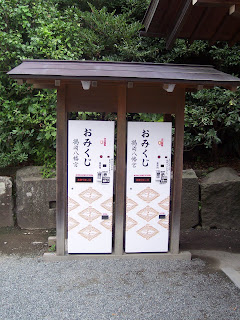First stop of the Saturday: Hokokuji, a Buddhist temple famous for its bamboo garden. All 18 students and our 3 helpful staff coordinators burst in upon the small building's grounds, which apart from the few moss-covered structures didn't seem to hold much. I refrained from paying
 the extra fee for green tea in the garden, but as soon as I'd entered the actual bamboo forest I realized that my critical judgment was made too soon. The stalks towered three stories above the small walkway, putting each of us back in our small place, and the tea house offered a lovely view of an almost invisibly sculpted garden. A small waterfall trickled away in the background as the others and I sat quietly, enthralled by the midmorning peacefulness.
the extra fee for green tea in the garden, but as soon as I'd entered the actual bamboo forest I realized that my critical judgment was made too soon. The stalks towered three stories above the small walkway, putting each of us back in our small place, and the tea house offered a lovely view of an almost invisibly sculpted garden. A small waterfall trickled away in the background as the others and I sat quietly, enthralled by the midmorning peacefulness.Quite in line with the foundational Buddhist doctrine of impermanence, we were soon shepherded off to the next destination: the Hachiman-gu shrine. It's named after the guardian deity of the Minamoto clan, which ruled the country from here (imagine the Greeks from the Trojan War or the North in the Civil War, as the historical reality is between those two struggles). In contrast to the tranquility of the temples, this place is paved with concrete and designed to lead its throngs of visitors to the altar for customary good-luck prayers and charm souvenirs--not very picture-worthy or enjoyable for me.
 I had to chuckle when I saw this, though. Where else but Japan could you find a fortune-telling vending machine?
I had to chuckle when I saw this, though. Where else but Japan could you find a fortune-telling vending machine? Later we went to the Daibutsu itself. I had seen pictures of the statue from a distance and was expecting to be underwhelmed, but I was again wrong. The colossal bronze figure was larger and more artistically serene in person, and despite the crowds it was easy to appreciate the sculpture's beauty. A lone pilgrim walked around the figure, chanting "Amida Buuuuuddha" with every step, and reminded me that this was not merely art or even a cultural symbol but a spiritual reality for many people there.
Later we went to the Daibutsu itself. I had seen pictures of the statue from a distance and was expecting to be underwhelmed, but I was again wrong. The colossal bronze figure was larger and more artistically serene in person, and despite the crowds it was easy to appreciate the sculpture's beauty. A lone pilgrim walked around the figure, chanting "Amida Buuuuuddha" with every step, and reminded me that this was not merely art or even a cultural symbol but a spiritual reality for many people there.This brings out a fundamental paradox in my studies: I follow Jesus alone yet study life patterns from an anthropological, relativistic perspective. This doesn't mean I am intimidated by the idolatry in these temples--their only reality is in the reactions of those who view them--but when there is no art to distract my mind, the depressing fact of false worship is all that's left. As a side note, I wonder whether I will ever be able to glimpse Japanese attitudes towards religion aside from the standard lines: "Japanese only follow rituals," "A Japanese person is someone who visits a temple at New Year's," etc. From the little I know, most people under 40 apparently believe in the shrines as much as I do.
There's little else interesting to share about the trip, but walking around much of the day (even without the characteristic humidity, thankfully) was pretty tiring, so I broke out my snack: a debeaked and dried cuttlefish. It was quite salty and therefore tasty, but there's a reason why the package has the word "chew" written five times on the front!
















